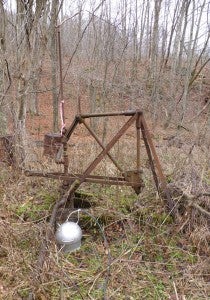By David Lyon and Adam Peltz
There are at more than 1.5 million inactive oil and gas wells in the U.S. that remain uncapped and, in some cases, unsafe. Some are temporarily dormant, while others are fully depleted but not yet properly sealed, continuing to emit residual pollution from the days when they were active. Many are what the industry calls “orphans,” with no financially solvent owner in sight to take the responsibility for them. Long seen as a water protection issue, a new study in the journal Geophysical Research Letters now shows that properly plugging unused wells can also reduce emissions of the potent greenhouse gas methane.
The study looks at orphaned and plugged wells in four oil and gas producing regions of the country – Colorado’s Denver-Julesburg Basin; Ohio’s Appalachian Basin; Wyoming’s Powder River Basin; and Utah’s Uinta Basin. It is part of a series of 16 major studies organized by Environmental Defense Fund to better understand the scale and scope of oil and gas methane emissions.
Long History and a Hodgepodge of Rules
People have been plugging oil and gas wells for almost as long as they’ve been drilling them. Left alone at the end of their life cycle, old wells all too often can emit methane and other pollutants into the air and water indefinitely. Early plug jobs sometimes used wooden logs to stop up boreholes. Technology has advanced considerably, relying on cement and mechanical barriers to ensure wells are isolated from groundwater and the surface. When plugged correctly, wells should not leak.
Every state has requirements for operators to plug wells at the end of their productive lives. But standards vary in quality and comprehensiveness, and wells often slip through the cracks if their operators go bankrupt prior to plugging their wells in the absence of adequate bonding – a financial commitment operators make to cover the eventual cost of plugging and remediation.
States that had early drilling booms have found themselves with considerable backlogs of orphaned wells – there are at least 150,000 of these on record and potentially hundreds of thousands of others whose locations are lost to history. Many states have programs in which the oil and gas agency takes responsibility for plugging wells out of bonding funds, voluntary industry contributions and fees. In some states this works very well, but in other states the funding is inadequate to the task of dealing with the volume of these wells.
New Study Zeroes In on Methane
In the new study, scientists at consulting firm GHD Services Inc., the University of Cincinnati, and Washington State University measured methane emissions at 138 abandoned wells. Out of over 100 plugged wells, just one was emitting methane, and only at a low level. By contrast, 40 percent of the unplugged wells were leaking methane, and the average leak rate was over 100 times higher than the single leaking plugged well. Overall, average emissions of unplugged wells were 5,000 times higher than plugged wells.
The moral of the story: plugging is effective for reducing methane leakage.
Although the researchers estimate that abandoned wells contribute less than 1 percent of regional methane emissions in the study areas, we still do not have a good idea of the magnitude of national emissions due to potential regional variability in emission rates and major uncertainty in the number of plugged and unplugged wells in existence. Uncertainty also is high due to the “superemitter” phenomenon, in which a small number of sources are likely responsible for the majority of emissions.
Plugging Away
Many responsible companies and states have good programs to plug wells – leading to some of the positive results found in the study. However, the study also shows the importance of addressing the vast number of orphaned and poorly plugged wells that remain across the country. And to work, wells must be plugged properly. States should continuously review their plugging procedures to keep up with the latest technologies and practices. Even wells that were properly plugged under historic regulations may require remediation if they show signs of leakage.
The methane emissions and contaminant leakage from orphaned and abandoned wells across the country add up, and it’s critical to continue to keep addressing them. Oil and gas regulators and operators must pay attention to the pollution created across the entire supply chain – not just the infrastructure currently in use, but also what’s reached the end of its lifecycle. We know that making the effort to plug the wells can put a big dent in oil and gas pollution – industry should take this opportunity to shows responsibility for its operations and regulators must also step up and hold them accountable for doing so.
Image Source: Alicia Iwanicki, GHD









